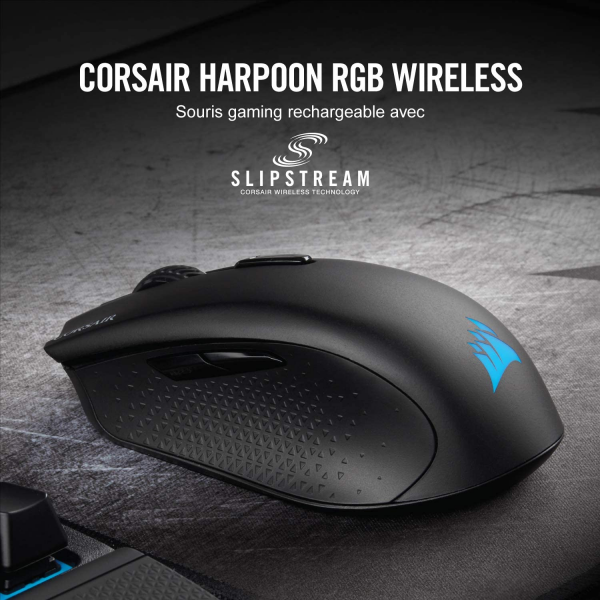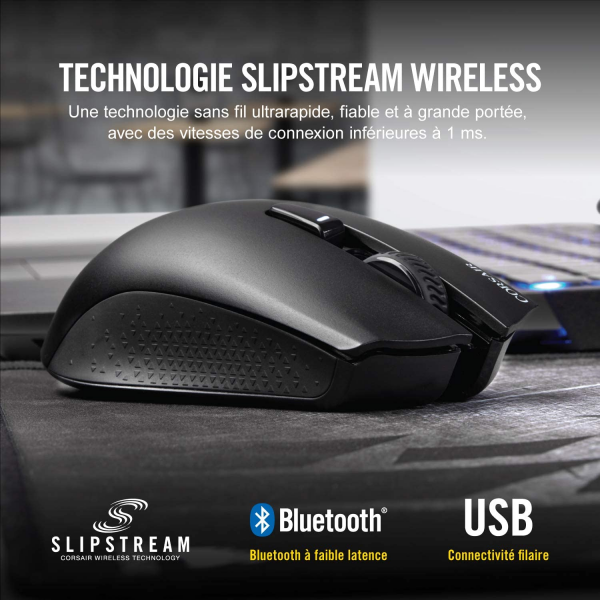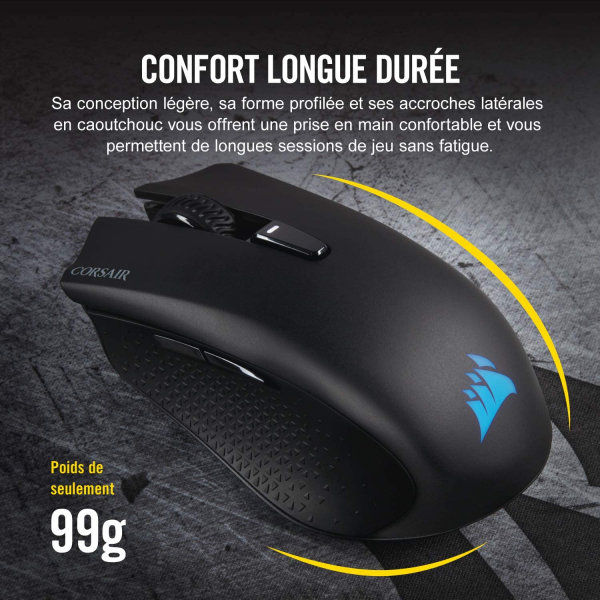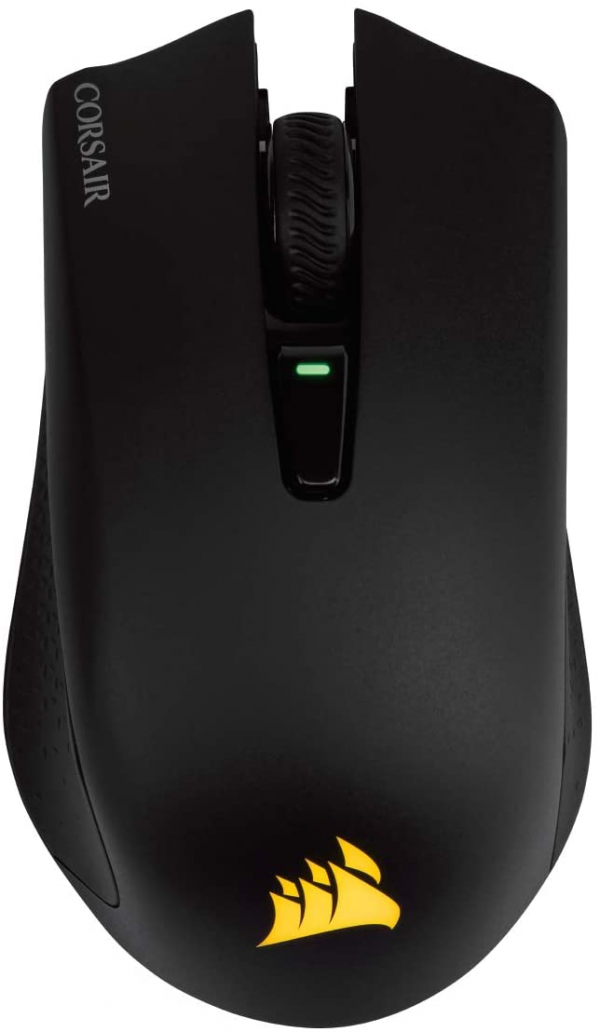Corsair
Corsair Harpoon RGB Wireless: it goes without wire without losing precision
Aprox. 51€
See specificationsAwarded with 4 stars during its test in early 2017, the Harpoon RGB comes two years later in a wireless version and with a new sensor. With its double rate, but still attractive, is it also recommended to play without breaking the bank?
Positive points
Good grip.
Quite light for a wireless mouse.
Satisfactory optical sensor.
Autonomy.
Also works in Bluetooth.
Bad points
Slice buttons not necessarily very easy to handle for large fingers.
For right-handers only.
Micro-USB connector very recessed: proprietary cable required.
Our review
Ergonomics
The Harpoon RGB in its Wireless version does not evolve in its form or in its materials. We are therefore in the presence of a mouse with a fairly common design, but all the same modern and in the purest style of the manufacturer: empty around the wheel, front part which ends in a point, hollowed edges ... And of course a clearly identifiable logo and always backlit despite battery operation.
The manufacturing quality is still good despite an all plastic construction and the use of a matte and rough plastic on the top. The latter has the advantage of being both not very dirty and non-slip, failing to be very pleasant under the fingers.
No change in dimensions (111.5 x 68.3 x 40.4 mm) - it is a relatively compact mouse -, but inevitably a few more grams for this wireless version with a battery: 101 g on our scale (99 g announced by Corsair). A controlled mass which always allows handling with the fingertips or in claw. Unless you have small hands, putting your palm there results in fingers sticking out of the buttons, which is not a recommended use.
The grip is nevertheless comfortable. Designed for right-handers, the shell is tilted to the right to better conform to the shape of the hand. We also appreciate the well-dug slices covered with a textured elastomer material which prevents fingers from slipping. Convenient for lifting the mouse when it comes to refocusing it on the mat; which we do constantly if we use a fairly low sensitivity.
Same observation at the level of the two main buttons which welcome the fingers well thanks to their curved shape. These are associated with reactive Omron switches and guaranteed for a minimum of 50 million activations. They are however not very silent.
The Harpoon RGB Wireless also offers two buttons on its left edge, which are also reactive. Quite small, they are not necessarily easy to activate in the heat of the moment, especially if you have big fingers, especially since they are slightly removed from the shell and very close to one of the other. The closest would also have benefited from being a little larger to be more easily operated with the middle of the thumb. These slice buttons are associated by default with the "next page" and "previous page" functions in office automation, but this association can be changed, like that of the other buttons, in the iCue configuration software (see box).
A fifth button finds its place above the wheel and is used to change the sensitivity of the sensor. Its recessed position requires a small gymnastics of the index to activate it. A small led is embedded there and changes color to match that of the sensitivity level which is activated. Handy if you remember the color code you assigned in the settings. The last button is located as usual under the wheel and is quite easy to press. The wheel, for its part, is well notched without being too hard to scroll.
The small size of the PTFE pads of the Harpoon RGB Wireless does not prevent a fairly fluid glide, the mouse remaining fairly light.
In terms of autonomy, the Harpoon RGB Wireless is doing quite well for a mouse dedicated to the game and which must therefore offer first-rate performance - often at the expense of energy saving. It can thus last 30 hours in high performance link with backlight on, 10 hours more in Bluetooth and up to 60 hours in energy saving mode. Sufficient to play for several days without worrying about the charge level in any case, but it will be necessary to make sure to plug it in from time to time to avoid the breakdown.
We can also very well use it by wire. Just plug the cable from the front of the mouse into the micro-USB port. Alas, it is positioned very far from the edge, under the wheel, making it impossible to use a standard cable.

Precision
Small sensor change for this Wireless version, here we go from PMW3320 from Pixart to PMW3325. The latter is a little faster on paper, still supporting accelerations up to 20 g, but now slightly higher speeds of up to 2.54 m / s (against 2.03 m / s). The maximum sensitivity of the sensor reaches 5,000 dpi and Corsair logically doubles it to 10,000 dpi, which is still useless since already at 5,000 dpi, a simple displacement of barely 2 cm is enough to travel the full width of an Ultra HD screen. Suffice to say that even playing with this definition with this already very high sensitivity, it is dizzy.
In practice, this change of sensor does not change much, the mouse responding even to the fastest movements. Players with a low sensitivity level may prefer to opt for a faster sensor, for safety, but during our tests, even by moving the arm as quickly as possible, we did not observe any dropout.
No improvement, however, in terms of the height of the sensor dropout (lift-off) which remains quite high and may precisely disturb game enthusiasts in low sensitivity who would appreciate not seeing their camera move when replacing the mouse.
No problem to report in terms of surface recognition, rather good for an optical sensor, since the Harpoon RGB Wireless even accepts to operate on certain glossy and somewhat transparent coatings, such as plexiglass (as long as it is not immaculate and without scratches .. .), shiny book covers, etc. However, we can only recommend the use of a mouse pad so as not to risk a loss of precision, improve the sliding comfort and reduce the wear of the skates at the same time.
Regarding the wireless connection, compared to a wired operation, we did not note any drop in performance when the mouse is connected via its small USB adapter in proprietary radio protocol. The connection is stable and the latency imperceptible. This is however not the case in Bluetooth mode, which must be reserved for office use because of the low latency inherent in this technology.

Conclusion
Despite a significantly higher price, the Harpoon RGB Wireless keeps the philosophy of its wired elder. Its moderate price does not prevent it from offering good performance and allows it to display a very good value for money.

Specifications

